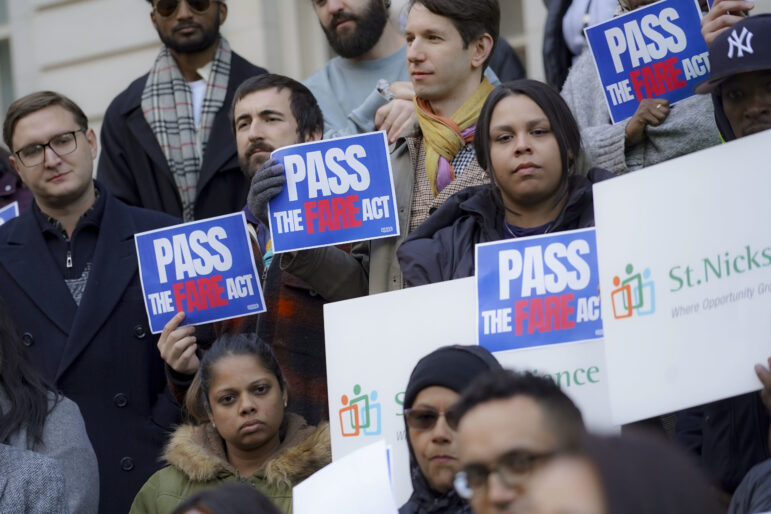Photo by: Colin Lenton
Some estimates suggest that at one point last year, black male unemployment in Red Hook hit 46 percent.
In March, as the national unemployment rate remained at 9.7 percent for the third straight month, the rate for black men rose to 20.2 This month’s edition of City Limits magazine presents a comprehensive investigation of the causes, consequences and political controversy of black make joblessness. In this web extra, we look at why some feel the federal stimulus bill has come up short.
In a recent column, the chairman of the board that oversees the federal stimulus program went on the defensive against the chorus of attacks his agency has faced, aiming to shoot down critiques such as “Why is the Recovery Board wasting so much money funding stupid projects?”
“Over the past year, the Recovery Board has received its share of gratuitous criticism from some journalists and Internet grouches,” began Earl Devaney, chairman of the Accountability and Recovery Board. Devaney’s 700-word screed addressed a variety of criticisms, but ignored the growing complaint that the stimulus program is not doing enough to help the demographic groups hurt most by the recession, especially black men.
American Recovery and Reinvestment Act (ARRA) spending—a combination of tax cuts, social safety net spending, assistance to local governments and infrastructure investment—is credited with creating or saving 1.6 million jobs to date. And, according to a report by NYU’s Wagner School’s Women of Color Policy Network, about 25 percent of the jobs created by the stimulus will go to blacks and Latinos—who together comprise about 26 percent of the workforce. But, the report notes, “the Reinvestment act would only decrease the unemployment rate of African Americans and Latinos to 10.7 percent,” still above the white rate at the depth of the recent downturn.
Critics say the stimulus’ shortcomings stem from design flaws. “I don’t think there was enough understanding of what was going on in communities of color. I don’t think that happened on the first go-round,” says Nicole Mason, a Wagner School professor and author of the report. “In the first stimulus bill they targeted construction, infrastructure. If you looked, you saw right away that blacks were underrepresented in those industries.” And black- and Latino-owned firms have received disproportionately small shares of stimulus work.
But the dissatisfaction with AARA also reflects the mismatch between it—a measure meant to kick-start a broader private job boom, and to do so over a number of years—and the scale of the recession. The 1.6 million jobs AARA has created or saved so far pales compared to the 4.8 million that the national economy has shed since 2008. ARRA will eventually provide or save 6.8 million jobs (that’s the estimate by the President’s Council of Economic Advisers) but that impact will unfold between now and the end of 2012. Only about 38 percent of the $787 billion in spending appropriated by the bill has actually been paid out. The rest will flow into the economy over the next three years. What’s more, because ARRA was meant to be a temporary measure to respond to the unique crisis of the recent recession, it doesn’t address the black-white employment disparity, which dates to at least 1940.
The President called for additional job creation measures in his January State of the Union address, but black leaders are pressing for aid more specifically targeted to high-employment areas. And it’s not clear that Congress is willing to spend much more on job aid of any kind. The House passed an ambitious, $154 billion jobs bill last year. But so far, the Senate has only agreed to an $18 billion measure passed in March that, among other things, provides tax breaks to businesses who hire new workers who had been unemployed for at least two months. Senate Democrats hope to pass subsequent jobs bills, but with deficit hawks circling, it’s unlikely that Congress will embrace anything like the ambitions of Congressmen Keith Ellison of Minnesota, Jerrold Nadler of Manhattan or George Miller of California—Democrats who have proposed targeted job help for disadvantaged groups, a mini-WPA offering transit jobs to disconnected youth and a $75 billion plan to create 750,000 jobs, respectively.
The stimulus probably deserves more credit than it gets for directing assistance to unemployed black families. Arloc Sherman, a senior researcher at the Center on Budget and Policy Priorities in Washington, estimates that 6 million Americans might have fallen into poverty were it not for some of the social insurance provisions in ARRA. Compared to past recovery bills—such as the Bush administration’s 2003 tax cuts—the Obama stimulus spread the wealth. “I think it’s fair to say this is one of the most balanced responses by Congress to a recession intended to shore up the economy that this country has seen in living memory—Balanced in terms of trying to make sure everyone gets help,” Sherman says.
But President Obama is under increasing pressure from black lawmakers to target relief to areas suffering high unemployment. The question is whether merely creating jobs—even directly by the government—can make a dent in problem that has dogged the country since World War II.
“I don’t think we can cut the unemployment rate in half without addressing some of the structural, historical barriers. There’s just no way around it,” Mason says. “We really just have to roll up our sleeves and say, ‘What is going on here that’s different than the general population?’ It’s not just that people aren’t building houses anymore. It’s a longer, more insidious problem that we haven’t had the opportunity to address. Maybe now we do.”








